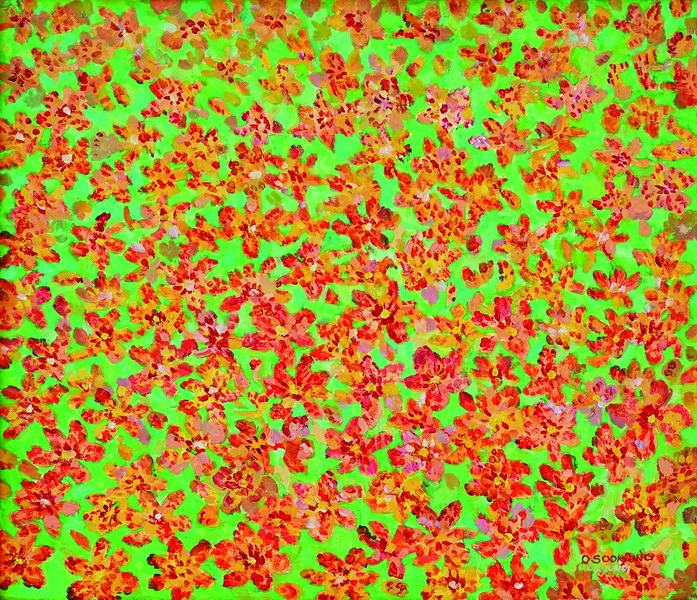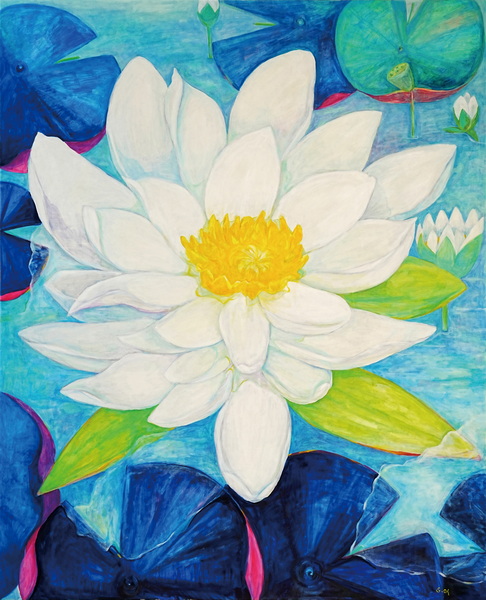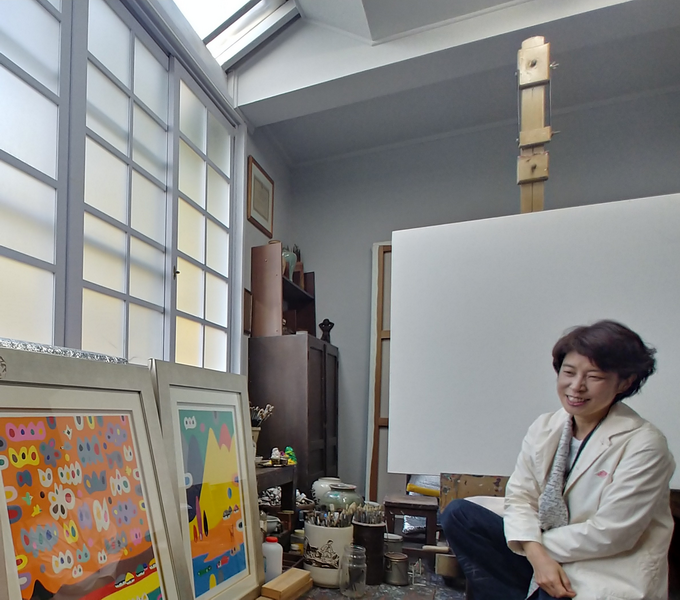Painter of the “Halo Effect”: Oh Soo-kyung
By Kang Jennis Hyunsuk
Last spring, I went to a department store in Gwangju. There I was attracted by the poster for an art gallery. When I followed its directions to the gallery, I found a refreshing combination of green leaves, colorful flowers, and fruits in oil paintings.
It was glamorous and fancy artwork from a distance, but when I had a closer look, the paintings revealed a simple beauty, like that of a woman with light makeup. At the time, I wondered how they could have this double beauty. I’d always thought that the charm of oil paintings was to have a thick texture. I was shocked by this new style in oil paintings, so I asked the artist for an interview.

The place I visited to interview the artist of these paintings, Oh Soo-kyung, was at her mother’s house where the painter Oh Ji-ho (1905–1982), her grandfather and a master of modern Western painting, had once lived and worked. Currently, Oh Soo-kyung’s mother lives there, so it was an honor for me because the complex is not open to the public at all times for privacy reasons. The interview was conducted in the studio that the artist Oh Ji-ho and his son, Oh Seung-yun (1939–2006), had once used. Now Oh Soo-kyung sometimes paints in the studio, adding her paint stains to the floor like her father and grandfather before her. Here is our interview.
Jennis: Thank you for your time. I really enjoyed your unique paintings of flowers and fruits at the exhibition. In your paintings, I felt that the natural objects such as flowers and leaves were free from their original shapes and colors. I wonder if you paint by diluting the paints with lots of oil because your paintings are so translucent.

Oh Soo-kyung: I hear that from time to time. Some people have wondered if I’m trying to save on paints. Actually, no. I use a lot. When I color, I don’t color an object all at once. Because of the nature of oil paints, it takes some time to dry. I apply one color and leave it on the canvas to soak in. If I wipe it off before the paint dries, the canvas is lightly colored. Then I add another color, brushing it on the canvas horizontally and vertically like weaving cloth.
Jennis: Your work is like dyeing the canvas, similar to dyeing one’s fingernails with balsam flower petals. I think it takes a lot of time to complete a large canvas. Your style of work seems very different from those of your grandfather, the artist Oh Ji-ho, and your father, the artist Oh Seung-yun. What do you think?
Oh Soo-kyung: Yes, by nature of being a painter, I have to have my own unique world of artworks. So, I’ve had a lot of time to think about finding my own direction in art, with influences from the paintings in my family that I’ve seen from a very young age and the abstract art that I majored in at university.
Jennis: Oh, you majored in abstract art. By the way, I can see many flowers, trees, and fruits in your artworks. I wonder what exactly you wish to express through them.
Oh Soo-kyung: Flowers are often used as the subject for my paintings, perhaps because I grew up looking closely at the flowers blooming in the yard, thanks to my mother, whose hobby is growing flowers, shrubs, and trees. When I look at flowers, I sometimes feel something surrounding them. Like the rings of light that surround the moon and the sun, I wanted to capture the energy of flowers, which I can feel but cannot actually see. It might be an influence from the abstract art that I majored in. I like this effect of art – art changing itself over time. It can be called “the art of time.”

Jennis: I don’t remember where I read it, but I remember the saying, “A painter is a person who paints something invisible and allows people to see it.” Your words about the aura, or the “halo effect,” surrounding flowers remind me of my grandmother who prayed to the god of the trees, the god of the grains, the god of the moon, and the spirits that exist in everything.
You’re a third-generation artist in a family of artists, which includes your father and grandfather, and also your uncle Oh Seung-woo. Do you have any other relatives working in the arts?
Oh Soo-kyung: My two younger brothers and my cousins work in art-related fields. And my daughter is also doing her doctorate in the art history of Northeast Asia in the United States. Although she was not born in Gwangju, she is proud of Gwangju’s May 18 Democratization Movement, which was a milestone in Korea’s democratization, and she loves Gwangju people so much.
Jennis: So, including your daughter, four generations have been working in the arts. Did you have the urge to become a painter since you were young? I wonder what your childhood was like and the atmosphere around a family of artists.

Oh Soo-kyung: My father was my grandfather’s second son, and they lived together. The eldest son, my uncle, was active in Seoul, leading a large organization called Mogu-hoe (목우회), which represents Korea’s conceptual art. When my grandfather was a professor at Chosun University’s College of Fine Arts, he built this studio in the yard and painted there like a monk. It is said that he had the window placed facing north to minimize the change of light and the flow of time. He was very nice to me, but when he entered his studio, I wasn’t allowed to open the door. When he finished his painting for the day, my mother would wash and dry his brushes.
Jennis: Oh, your mother was like his apprentice. I can guess that she surely respected her father-in-law. And I want to ask who you think is the artist that influenced you the most.
Oh Soo-kyung: It’s hard to choose just one person, but I think I got a lot of help from my father, who recommended that I go to Ewha Womans University to study art. He studied at Hongik Art College and lectured in the College of Art at Chonnam National University. When he stayed in France, his works in our five traditional Korean colors received lots of attention. He expressed the harmony between nature and humans with soft curves of mountains, rivers, and fields, and I consider him to be my respected senior artist. He always told me not to fall into the mistake of merely carrying the outward appearance of a painter, but to be a faithful person inside. I cherish and attempt to keep those words of advice.

Jennis: Oh, a few years ago, I saw the exhibition by your father, Oh Seung-yun, at the Lotus Gallery at Mugak-sa, the temple in the Sangmu district. I still remember his moving artworks. He expressed our traditional philosophy of the universe as being composed of yin and yang in five colors: blue, red, yellow, white, and black. Please let me know what your plans are for the future.
Oh Soo-kyung: Like my work Apple Tree, I am planning to create a series of paintings of the light of the sky and the colors of the air between the leaves. I want to deliver what I feel from nature. While my father painted the traditional five colors, I’d like to paint the diverse spectrum of light with another five colors.
Jennis: I’m rooting for your new series with its five other colors. Thank you for this extensive interview!
After the Interview…
The artist, Oh Soo-kyung, painted in Texas for five years before recently returning to Korea. Her stay in Texas – where the endless horizon meets the equally endless sky – made her feel that the sky is always with her. This experience is now expressed in her paintings as fresh air between leaves and petals. I send my encouragement for her new style in painting.
Solo Exhibitions
- 2022 Individual Exhibition (Lotte Gallery, Gwangju)
- 2019 Individual Exhibition (Gallery of Jangseong Library)
- 2017 Individual Exhibition (ACC Hotel Gallery, Gwangju)
- 2007 Individual Exhibition, Secret Garden (Hang Gallery, Seoul)
- 2005 Invitation Exhibition of Chung-Ang National University (Central National University Museum of Art, Beijing)
- 2005 Art Seoul Exhibition (Seoul Arts Center, Seoul)
- 2003 Individual Exhibition (Shinsegae Gallery, Gwangju)
- 1997 Individual Exhibition (Chohung Cultural Center, Gwangju)
Main Collections
- Seoul Museum of Art (Seoul)
- Gwangju Museum of Art (Gwangju)
- Hong Kong Embassy’s official residence (Hong Kong)
- Beijing Embassy’s official residence (Beijing)
The Interviewer
Jennis Kang has been living in Gwangju all her life. She has been painting in oil paints for almost a decade, and she learned that there are a lot of fabulous artists in this city of the arts. As a freelance interpreter, her mission is to introduce Gwangju’s wonderful artists to the world through English.







